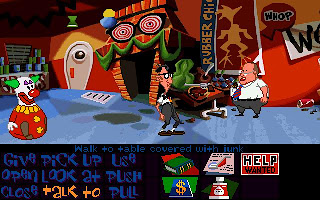With the release of C# Game Programming: For Serious Game Creation, I've got a nice code base to create cool new examples and experiments and recently I've been thinking about adventure games.
Adventure games, the red headed step child of gaming, once so popular, now living in the basement, rarely making an appearance. Lucas Arts used to make some excellent adventure games, until they went mental and closed down lots of their studios so they could concentrate on funnelling large amounts of cash into the various Star Wars games that tended to implode. But before the crazy took hold some truly excellent games were created. Just in case you don't remember how excellent here's a fistful of nostalgia:
Day of the Tentacle! Awesome.
The Dig! Only game that's ever really felt like a movie to me (in a good way :))
Loom - if you've never tried this I recommend it. Something that you probably wouldn't see produced by the mainstream western games industry today.
Monkey Island - god I love a good "Meanwhile..." sequence.
Sam and Max Freelance Police another great adventure game
Full Throttle! Yes - this is how you create a believable fantastic world.
So I think the conclusion we can come too - adventure games were awesome and their departure left a gaping hole in the heart of many gamers. How did they fill this hole? They started making their own adventure games, using tools like the AGS - Adventure Game Studio. People have done wonderful things with AGS but it's an old tool and the age shows. The scripting language is totally cargo cult land, a design that seems to come from guessing how how programming languages work - no arrays or any type of containers? Please!
So what's the first step you'd need to take, as a programmer, to make an adventure game? I think it would be a character walking around - moving the character and playing a walkcycle that'd be pretty simple, the harder bit would be defining where the character could walk and were they couldn't. To illustrate this:
The red area is the area where the character can walk. Click anywhere in this area and the character will walk the there. Conversely
This is area were you can't walk.
Tangent: So Japanese and Chinese - have you ever noticed they don't use the Roman alphabet? Lots of symbols instead, that's what you get when you've never had Pax Romana. Both Chinese and Japanese use lots of symbols known as kanji or hanzi and two of these symbols are:
凹
凸
The top is concave and the bottom one is convex and you're always going to know what those words mean when you read them. The meaning is encoded in the symbol! Crafty! The Roman alphabet has a similar history but it's largely forgotten and not really as useful - for example the letter 'A'.
Yes the letter A is supposed to come from cow? Who would have seen that!
The areas in adventure games were you can walk can be defined using one or more polygons. To be able to defined any area with a polygon it means we'll have to write some code that can deal with concave polygons. It's pretty easy to work with convex polygons - in fact OpenGL only supports the drawing of convex polygons but working with concave polygons is a little more difficult.
In the original Monkey Island code I suspect they didn't do anything with polygons, instead I think they would have had a bitmask over each scene. Then the mouse pointer position could be used to index the bitmask and find out if it's a walkable area. This is an easy way to program when you're accessing the frame buffer directly but these days most graphics are passed on using vertices, triangles and whatnot making it a little harder to use a pixel based scheme. The polygon way is also far more efficient and compact allowing it to be easily used with scenes that have much higher resolutions. (It's also applicable to other types of game, games like Baulder's Gate probably used a polygon based system to decide where the players could walk)
My little project allows the user to drop vertices and the program links them together. The user can click the starting vertex to close the loop and form a polygon. At this point the polygon is filled in. In the case of a concave polygon, it has to be broken up into a number of convex polygons so OpenGL can draw it. Here's a screen shot.
This should be quite easy to move into an adventure game and I think I'll be looking into developing that first step. I want to get a character walking around a 2D scene with certain areas blocked off. I've not gone into the actual code but high level it's pretty simple - each area is a list of positions, this list can be transformed into an outline / triangle representation to feed to OpenGL so it can be visualized. To make the system useful for programming adventure games there needs to be a intersection test for a point - which I've written but haven't tested and a little code to save the data out.
Once I get a little further on in the dev stage I'll upload it as another example project for the Engine.










No comments:
Post a Comment